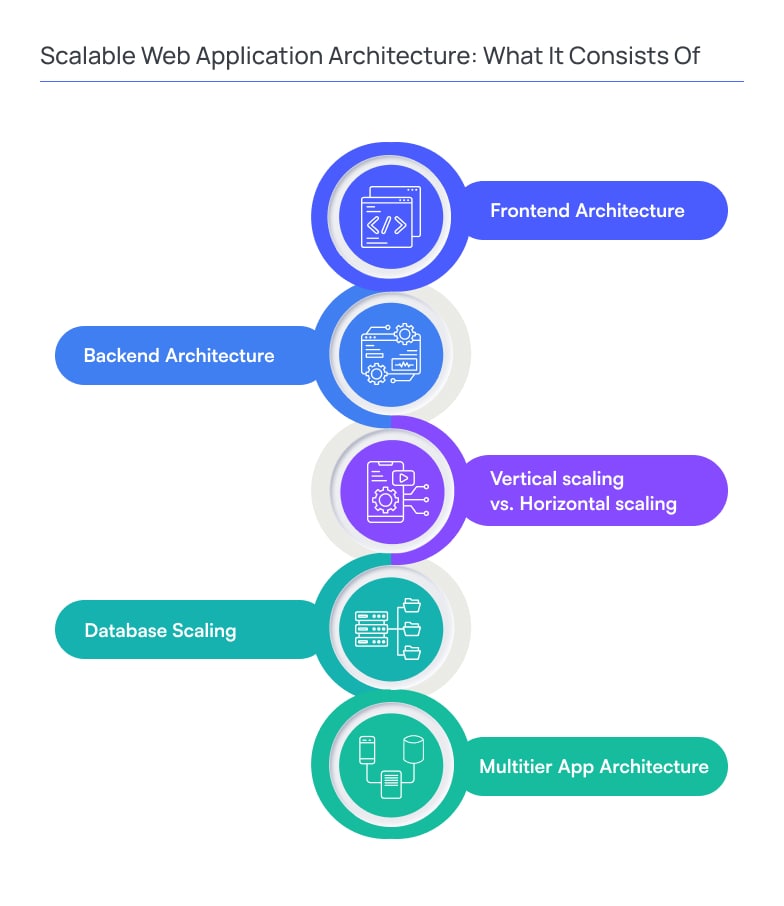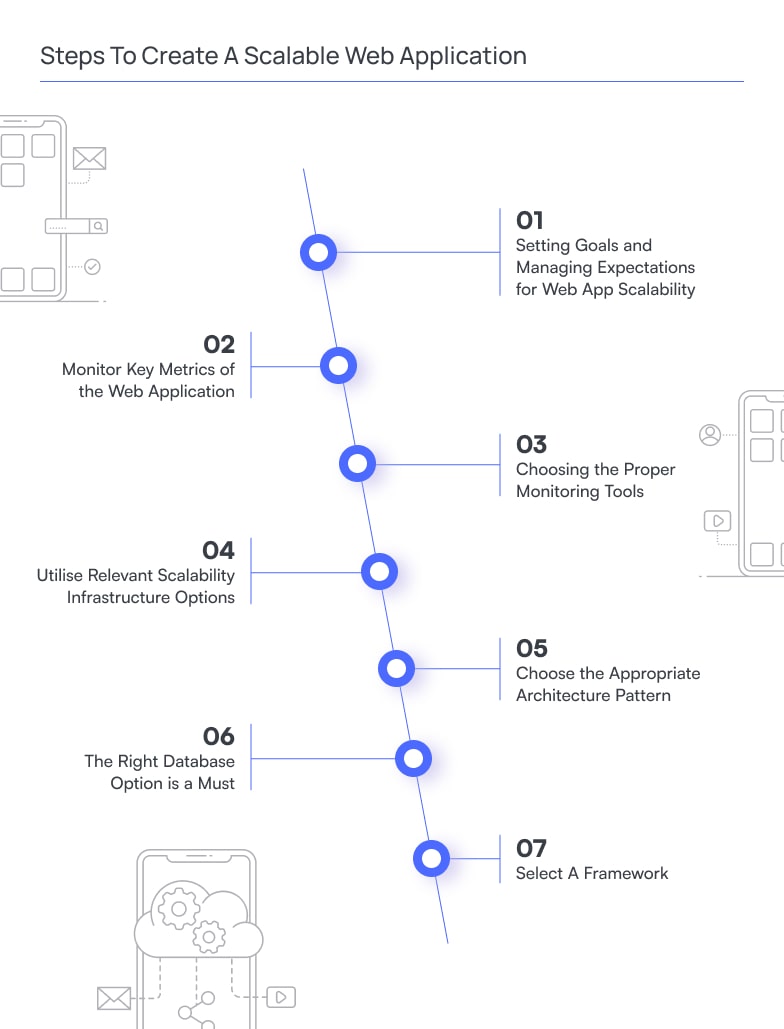Today online businesses strive to attract and retain a growing user base, and building a scalable web application has become crucial for success. Scalability refers to an application’s ability to handle increasing user load and growing demands without compromising performance or user experience. Whether launching a new startup or expanding an existing business, creating a web application that seamlessly accommodates growth is essential.
This article dives into the intricacies of developing scalable web applications, highlighting the critical factors to consider and the steps involved in achieving scalability. From selecting the right technologies and architectural frameworks to implementing efficient database management and optimizing performance, we will explore the key elements necessary to create a robust and scalable web application.
By understanding the principles and strategies behind scalability, businesses can ensure that their web applications can handle increasing traffic, provide a seamless user experience, and effectively adapt to evolving user demands. So, let’s delve into scalable web application development and discover how to build a solid foundation for sustained growth and success.
What Is a Scalable Web Application?
Scalability is a fundamental aspect that defines the elasticity of a system. When it comes to web applications, scalability refers to their ability to handle a growing number of users and increase loads without compromising performance or causing disruptions to the user experience. It reflects the software’s capacity to adapt and grow in response to user demands.
Measuring the scalability of an application involves evaluating how effectively it can support simultaneous requests. Achieving scalability involves adjusting network bandwidth, CPU, physical memory requirements, and hard disk configurations. It requires careful application configuration, aligning the proper software protocols and hardware infrastructure to handle a high number of requests per RPM.
Ultimately, the overarching goal of scalability is to guarantee a consistent user experience, irrespective of the number of people utilizing the application. It enables businesses to accommodate growth, maintain performance levels, and meet the expectations of their user base. By building scalable websites, organizations can position themselves for success in an ever-evolving digital landscape.
Scalable Web Application Architecture: What It Consists Of
Many individuals mistakenly believe that creating a scalable product significantly differs from any other development process. However, the distinction lies in the finer aspects.

The key to success is building a highly scalable web application architecture. By implementing core components into its structure, you can avoid rebuilding the application or rewriting the code when performance improvements are required.
Here are some primary factors to consider when developing a product with the potential for expanding its capabilities.
Frontend Architecture
The front-end component of web architecture directly interacts with users and represents the user interface template with all its functionalities. In a scalable web application, the efficiency of the front end depends on the reliability of the back end.
However, specific techniques can strengthen the front end of your app. For example, Content Delivery Networks allow the delivery of heavy content to multiple locations via numerous servers, ensuring satisfactory loading speeds for end-users, regardless of their request source.
Backend Architecture
The back-end infrastructure serves as the core of web application architecture. It handles all server-based operations, ensuring efficient functioning of the front end, proper request processing to the database, and timely responses in the user’s browser. The backend system forms the basis for user-app interactions, and most performance issues tend to be backend-related.
Typically, all user requests are handled by a single server, leading to failures and reduced loading speed. When such problems arise, it is time to scale the server side of your app. It can be achieved through vertical scaling, which involves increasing the server’s capacity, or horizontal scaling, which entails adopting a multiple-server solution.
Vertical scaling vs. Horizontal scaling
While vertical scaling focuses on enhancing the capabilities of existing servers, engines, and nodes to improve performance, it may only address temporary issues and lacks alternative backup options in case of system failure.
On the other hand, horizontal scaling offers a robust solution for building scalable web applications. It involves adding more servers and nodes to the system, effectively distributing queries, and reducing the load on individual servers. This approach enhances efficiency and reliability by allowing the system to handle increased traffic without relying solely on a single server.
One of the key advantages of horizontal scaling is its ability to provide backup options. If a particular part of the backend becomes overwhelmed, the entire system won’t crash as the load is distributed across multiple servers. It ensures better fault tolerance and prevents single points of failure, improving overall system performance and reliability.
By adopting horizontal scaling, web applications can achieve better scalability, handle higher traffic volumes, and maintain a consistent user experience. It offers a scalable and resilient architecture that can adapt to changing demands and provide uninterrupted service even during peak usage.
Database Scaling
Database scalability is another crucial aspect in ensuring high performance for your web application. Managing the database can become challenging with increased data volume and simultaneous requests. Techniques like replication and sharding can address these issues.
Replication involves creating database copies and distributing specific request segments across the network, improving data recovery and read performance.
Sharding involves distributing data across multiple databases to handle specific query portions. It allows for adding more nodes as the user count increases.
Multitier App Architecture
The multitier approach is often employed to build large-scale web application architectures. It typically consists of three modules: the client-side server, the application server, and the database server. These modules are physically separated into distinct layers, each focusing on achieving optimal efficiency without unnecessary burden.
The client-side modules prioritize serving the users’ immediate needs and ensuring user-friendly operations. The database server handles data processing and access privileges rather than dealing with static and mid-dynamic content. This precise distribution enables consistent scalability, seamless interactions, and balanced architecture.
By considering and incorporating these factors, building a scalable web application that accommodates growth, maintains performance, and delivers a satisfying user experience becomes possible.
Top Web App Frameworks To Make A Scalable Web Application
Developers commonly use several popular scalable web application frameworks to build robust and scalable web applications. Here is a list of some widely recognized frameworks:

Django. Django is a high-level Python web framework that follows the model-view-controller (MVC) architectural pattern. It provides a scalable and comprehensive toolkit for building web applications quickly and efficiently.
Ruby on Rails. Ruby on Rails, often referred to as Rails, is a full-stack web application framework written in Ruby. It emphasizes convention over configuration and follows the MVC pattern. RoR offers built-in scalability features and promotes rapid development.
React.js. React.js is a popular JavaScript library for building user interfaces. It allows developers to create reusable UI components and efficiently manage the application state. React.js is often used with other frameworks or libraries to build scalable web applications.
Laravel. Laravel is a PHP web application framework known for its elegant syntax and developer-friendly features. It provides a scalable architecture and robust routing, caching, and database management tools.
Node.js. This trendy and scalable web application framework is known for handling many concurrent connections with high efficiency. It utilizes an event-driven, non-blocking I/O model, making it well-suited for building scalable and real-time applications. With Node.js, developers can create server-side applications that are lightweight, fast, and scalable. Node.js allows developers to find a better way how to increase the scalability of a web application effectively.
Don't let your app lag behind. Scale it up for success! Let Binerals help you
Contact usSuccessful Examples of Scalability In Web Applications
What scalable apps are available in the market? There are many scalable apps, and we bet you use some of them daily. Here is the list of a few successful examples below:
Netflix. Netflix is a popular streaming service that delivers a vast library of movies and TV shows to millions of users worldwide. It has achieved remarkable scalability by utilizing a microservices architecture, allowing them to handle high traffic loads, provide personalized recommendations, and seamlessly stream content across various devices.
Slack. Slack is a communication and collaboration platform used by teams and organizations. Its ability to scale seamlessly has gained popularity, allowing users to communicate in real-time, , share files, and collaborate on projects. Slack has implemented a distributed architecture that enables horizontal scalability, ensuring reliable performance even with many concurrent users.
Uber. This taxi app revolutionized the transportation industry with its on-demand ride-hailing platform. It has successfully scaled its app to serve millions of users globally. Uber’s scalability is attributed to its use of microservices architecture, real-time data processing, and efficient allocation of drivers based on demand. These strategies have enabled Uber to handle high volumes of ride requests and provide a smooth user experience.
Instagram. Instagram is a popular social media platform for sharing photos and videos. It has experienced rapid growth and managed to handle the increasing user base by employing scalable infrastructure and optimizing its backend systems. Instagram utilizes sharding techniques to distribute data across multiple databases and uses caching mechanisms to enhance performance and response times. You can find more information on how to create your own social media app if you choose this niche for business.
Moreover, many entrepreneurs today are looking for ways to replicate the success of Instagram. That is why we have written an article that explains how to make an app like Instagram.
Steps To Create A Scalable Web Application
Scalable web app creation is challenging, and we recommend you entrust it to professionals like Binerals to avoid mistakes and unnecessary costs. However, you need to understand this process and what steps it includes.

Setting Goals and Managing Expectations for Web App Scalability
Scalability is crucial for web applications, but evaluating your needs and goals is essential before scaling your app. Scaling can be complex and expensive, so careful planning and evaluation are necessary.
Scalability becomes critical when dealing with large projects that experience high volumes of user traffic. If your app is growing rapidly and attracting many users, scalability may be necessary to ensure smooth performance and user satisfaction.
Conducting market research is essential to make an informed decision about scaling your app. Understanding industry trends and the scalability needs of large enterprises and fast-growing startups will help you gauge the importance and viability of scalability for your particular project.
Monitor Key Metrics of the Web Application
Monitoring relevant metrics and key performance indicators (KPIs) is crucial to efficiently determine the need for scaling your web application. By closely analyzing these metrics, you can identify scalability issues and make informed decisions about the necessary steps to enhance your application’s performance. Here are some critical scalability metrics to monitor:
- Memory utilization analysis. Evaluate the average memory utilization statistics, considering the percentage of available memory used. This analysis provides insights into how effectively your system handles the load. Monitoring memory utilization helps identify if scaling is required to accommodate increased user traffic and data processing demands.
- Disk input/output. Measure the active disk input/output time, which encompasses reading and writing operations, typically measured in kilobytes per second (KB/s). Monitoring disk I/O provides valuable information about data transfer efficiency to and from the disk. It helps identify potential bottlenecks that could impact the application’s scalability.
- CPU usage. Keep a close eye on the percentage of CPU utilization over time. Monitoring CPU usage provides insights into the system’s processing power. Sustained high CPU utilization may indicate the need for scaling to distribute the computational load effectively and ensure smooth application performance.
Choosing the Proper Monitoring Tools
Once you have identified the key metrics to monitor, selecting the appropriate monitoring tools to track and analyze them effectively is crucial. While several options are available, prominent Platform-as-a-Service (PaaS) and Infrastructure-as-a-Service (IaaS) solutions offer reliable app monitoring capabilities. These tools are readily accessible to developers and simplify the monitoring process.
Utilise Relevant Scalability Infrastructure Options
After carefully monitoring your web application’s metrics, choosing suitable infrastructure options that support scalability is essential. When scaling your web app, we recommend leveraging Platform-as-a-Service (PaaS) solutions like Heroku or Infrastructure-as-a-Service (IaaS) platforms like AWS. These cloud services simplify the process of web app development and maintenance, making scalability more manageable.
Choose the Appropriate Architecture Pattern
This is another way how to scale a web application. Selecting the appropriate software architecture pattern is crucial for achieving scalability in your web application. Different patterns should be chosen based on user demand and performance requirements. Two standard options for scalability are microservices architecture and monolithic architecture.
Monolithic architecture. This architecture is typically suitable for small applications. It involves building a single extensive system with multiple features using a unified codebase. While it offers the advantage of simplicity and ease of development, a monolithic application can become challenging to manage as it grows in size and complexity. Adding additional features and functionalities to a monolithic app can lead to a bloated codebase and hinder scalability.
Microservices architecture. In contrast to monolithic architecture, microservices architecture consists of a suite of small, independent services, each with its codebase, logic, and database. These services are designed to perform specific functionalities and can operate autonomously. The lack of strict dependencies between modules in microservices architecture makes it easier to scale and offers more flexibility. Each service can be scaled independently based on demand, allowing for better resource allocation and efficient handling of increased traffic.
When choosing between these two architecture patterns, consider the size and complexity of your application and the potential for future growth. Monolithic architecture may be suitable for smaller projects with limited requirements. In contrast, microservices architecture provides scalability and flexibility for larger, more complex applications that are expected to evolve and handle high traffic levels.
The Right Database Option is a Must
Selecting the proper database is crucial when scaling your web application. The database choice directly affects the infrastructure and architecture of your application. Depending on the type of data you need to store, you have two broad options: relational databases (such as MySQL or PostgreSQL) or unstructured databases (NoSQL databases, like MongoDB). Both options offer advantages and considerations for scalability.
Select A Framework
When scaling an app, selecting the proper framework is crucial as it directly impacts its performance as new features are added. The choice of framework largely depends on the development language you prefer to work with. To ensure the best decision, consult a web app development company that can guide you in selecting the appropriate framework for your specific requirements.
A professional web app development company will consider factors such as the scalability needs of your app, the development language you are comfortable with, the complexity of features you plan to add, and the overall project goals. Based on these considerations, they can provide expert advice on the most suitable framework.
At Binerals, when we work on scalable web applications, two frameworks that deserve special attention are React.js and Node.js. These frameworks have gained significant popularity in recent years due to their unique features and capabilities that make them well-suited for scalable applications.
By focusing on React.js and Node.js, developers can leverage the benefits of component reusability, efficient rendering, unidirectional data flow, non-blocking event-driven architecture, and a rich ecosystem of tools and libraries. These frameworks provide a solid foundation for building scalable web applications, enabling developers to handle increasing user demands and deliver a smooth user experience.
To Wrap Things Up
Understanding how to improve the scalability of a web application is crucial for its long-term success. By following the steps outlined in this article, such as monitoring key metrics, choosing the proper infrastructure, selecting appropriate software architecture, and leveraging the power of scalable frameworks, you can ensure that your web application can handle increased user traffic and data loads.
Remember, scalability is about addressing immediate performance issues and preparing your application for future growth. It requires careful planning, continuous monitoring, and adapting to changing demands. With the right strategies, you can build a scalable web application that can effectively handle increased user demands, provide a seamless user experience, and support business growth.
You only need to cooperate with software development experts like Binerals – it will be your final step to success.
Embrace scalability for your web app. Let’s discuss your options
Contact Binerals!